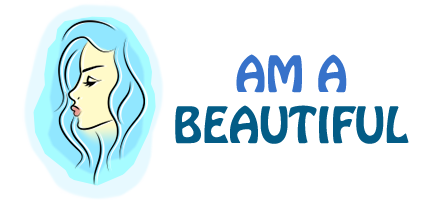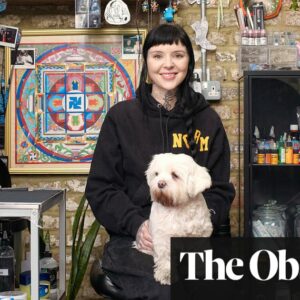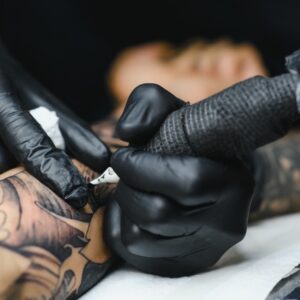Grace Neutral, London
Instagram has transformed tattooing. There was an old white man biker mentality when I started out – they were the gatekeepers. There was sexism, racism and an old boys’ club. The only way to cut your teeth and carve out a career involved apprenticeships in their shops. Now we can advertise ourselves. That’s what I do to my 500,000 Instagram followers.
That said, I hold a lot of traditional values in tattooing. There used to be a mystical magic about it, which doesn’t exist any more. And with the secrecy came tight-knit communities inside our industry. Almost like families. Now, the Internet lets you go solo, and do our own thing. For me, cultivating that community remains important. Because being a woman in tattooing – I was only 18 when I started out – was pretty tough.
I’d always been fascinated by body modification, whether with ink or piercings. I got tattooed through my teenage years. Mum had books in her art studio on body modification – I’d flick through and see these images and was enamoured by the beauty of it all. I grew up in Plymouth, and dropped out of school before GCSEs. I dossed about at art college, never quite finding a purpose. When I was 15, my friend asked me to book her a tattoo appointment. I popped into the shop to do it, and got one for myself as well – a heart on my leg. I felt this euphoria afterwards, an addictive rush of endorphins.
Back then, I didn’t think much about artistry or creativity. Only later – when I started to tattoo others – did I think more about my body as a canvas. That’s part of the evolution of the art. New tattoos can be designed to go over old. My legs now are on their third layer.
I was 18 and walking around Soho with a friend when I was handed a flyer for a tattoo studio. I walked in – with no experience – and asked for a job. I was offered a piercing apprenticeship. I borrowed the needles from the studio and printed off stencils. From then, I never wanted to stop.
It’s always been hand-poke I’ve enjoyed most – machines and I have never really bonded. I strap a needle to a piece of wood as a handle and hand-draw each dot. I’m known for symmetry and geometric work, mandalas and patterns using shading.
Tattooing is evolving. The industry is huge and it’s more accepted by society. Tattooists are celebrities in their own right. Put simply, tattoos got cool. People get tattooed for many different reasons: to heal or to rebel; for confidence, love or grief – but it’s always an expression of control. Of your body, of how you see yourself and how you’re seen, in a world where it’s hard to control anything.
I have a studio where I work three or four days a week, and we’ve got room for nine artists. We don’t have a shopfront – we rely on the internet, and word of mouth, for business. When people come to me, I show them some examples, and they let me get to work with a space on their body. I have free rein to draw and design as I see fit. That’s how to get the best out of me as an artist.
Doy, Seoul, South Korea
I’ve been tattooing in Seoul for 17 years, but the situation for artists like me here is complicated. Tattooing is heavily restricted by the state, and those of us who practise can face steep fines or jail time.
Historically, in countries like Korea and Japan, tattoos have been associated with organised crime. In both countries, the authorities used to tattoo criminals to visibly mark their sins on their skin. Criminals then used bigger and bolder tattoos to hide these marks. The results were large and colourful.
The government, therefore, wanted to destroy tattoo culture in the hope it would reduce violence. So, in 1992, the Korean courts announced tattooing would be considered a medical practice. You need to be a medical professional with a special licence to legally tattoo. It’s an entirely unnecessary law. In the past, it wasn’t uncommon to have resections on tattooing across the globe, but in the last 20 years that’s changed. Even Japan scrapped their equivalent law in 2020. Now it’s only Korea left lagging behind. It’s why for the past three years I’ve been working to build a tattooists’ labour union. We are 750 in number now, fighting to make tattooing legal across South Korea. But a cultural shift has already taken place. It might be illegal, but it’s incredibly common. One in four Koreans have some sort of tattoo on their body. You see them on celebrities, sports stars and politicians. Tattooing is estimated to be a 1tn won [£600m] industry in the country, forced underground. For me, it’s the battle of a lifetime. I was born and raised in Korea, and studied visual design at university. I worked for a while in UX design – but the job wasn’t paying enough, so I looked for other work. Then 17 years ago, I stumbled upon tattooing.
Our style of tattooing is revered and copied around the world – we are pioneers. We use needles to create fine art on the skin’s canvas, with a focus on texture, shading and fine lines. Our Korean style is an art form, studied and embraced globally. When I’m in the US tattooing celebrities such as Lily Collins and Brad Pitt, they treat me like an internationally respected artist; on Instagram, my professional account has close to 450,000 followers. But as soon as I touch down in Korea, and pass through customs, I am once again made out to be a criminal. My needles, machines and ink are seized by the government almost every time. Many tattoo studios are therefore kept secret, hidden from view
In 2021, I was found guilty and fined as a tattooist. I might still be sent to prison. And my case is a test for all those who face sentences: we have 25 lawyers working on my appeal. Right now, our chances don’t look good – most of our constitutional court judges have already made clear they’re against us. Still, everyone sensible in Korea knows tattooing needn’t be criminalised. There are currently at least six proposals floating around our parliament hoping to legalise tattooing once more. It’s just that 12 years since the first was tabled, nothing has been voted through.
Make Break Remix: The Rise of K-style by Fiona Bae is available now
Cake, Brooklyn, New York
I never had any training; there was no mentoring or apprenticeship. I watched a few videos on YouTube, ordered some books and worked it out as I went along. I’ve still had no formal training to this day. I’ve got a few tattooist friends, but I’ve never really felt I’ve fitted into the tattooing community.
My name is Samantha Robles, but I go by Cake and have done since high school. Supposedly it’s because I’m very sweet. I was lost in my teenage years. I didn’t go to school and wasn’t studious. I dropped out of college pretty much on day one. I was 18 and had started getting tattoos myself. I’d always drawn and for a few years messed around giving tattoos to friends in our bedrooms.
Wanting to give it a go, I went into a shop and tried to ask about how to get into the industry. It was all white men and they shot me down. I struggled to find the confidence to ask again, so didn’t bother. Instead I stuck to dishing out DIY designs and figuring it out on my own. Then I met my wife seven years ago – unlike me, she’s a goal-oriented, driven person. She pushed me to take myself seriously: step by step, I got to work. Now people travel from across the world to be tattooed by me.
The culture is changing and that’s important. I used to hear stories of people being assaulted by tattooists or facing abuse and violence in a position of vulnerability. And when I was coming up, we had black tattoo shops in the hood, and fancy white tattoo shops in the city – it was incredibly segregated. Thankfully, there’s a new direction now.
I’m still working out how tattooing translates into supporting my community, which for me is important. My art has helped raise funds for community fridges; when the hurricane hit in Puerto Rico, I created a sheet of specific tattoos and offered them to customers with all profits going to the relief effort. But as my work gets more popular, I’m having to grapple with how success fits.
As an artist in demand, to grow your business you raise your prices. If I was producing a product, I could just make more of it. But I have limited time in the day. Right now, my books are closed – it’s just too busy. I’m from the hood and don’t want to cut out the people from my community from accessing what I’m doing. I’m testing out free flash tattoo days for people on lower incomes; exploring how I might train others in this form of art. Thinking of tattooing only as a transaction leaves me feeling guilty.
It’s funny. In some ways, tattooing scares me more now than it used to. The permanence of it I find at times overwhelming. As I’ve gotten older, my appreciation of what giving a tattoo to someone means has grown. They’re choosing to give me a piece of their body – that’s a real responsibility.
Rebecca Vincent, London
My average customer is a woman about my age, 38, getting their first or second tattoo. They’re often at transformative moments in their lives: refinding themselves after early motherhood; hitting a big milestone birthday; navigating through a divorce. It’s all sorts: judges, vicars, teachers, doctors and nurses, and accountants. Generally, these are women who never thought tattoos could be for them. Now they’re a little older, they’re taking control of their bodies – it’s an expression of freedom and autonomy. They’re celebrating their flesh and bones when some in society would have us think we’re over the hill. For me, it’s a pleasure to be part of their process of discovery and reclamation. That’s what tattooing offered me.
I’m from South Yorkshire originally. Before having my kid, I worked in hospitality. I was 20 when I got my first tattoo. It felt exciting, offering me new ways to explore my body. For me – much like many of my clients today – tattoos helped me gain body-confidence, and boosted my self-esteem. Soon, I was getting more. I was obsessed with all of it: the process, the history, the artistry. I still have no regrets, each is a memory. It was around then I got the word “DINOSAUR” inked across my knuckles…
I was loving it, but my friends were worried. There were these presumptions – stereotypes – about what it meant and what they made me. It even comes up in therapy: what do you think this tattoo “thing” is all about? It’s presumed to be a problem, especially for women. My parents weren’t impressed at first, although I tattoo my mum now. They thought (as is the age-old misperception) that it was all criminals and sailors. I saw things differently, but never imagined I could be a tattooist myself.
And then I had a baby. I couldn’t go back to working in a pub – the hours just didn’t work with being a new parent. A friend suggested I try tattoos. I was reluctant. I didn’t see a way in. And I’d neglected my own artistry for a decade, ever since failing art at college. But after that conversation, I couldn’t shake the idea. I started to draw again in brief spurts when the baby was sleeping. All these images from nature started flowing from my hand. Soon I was drawing all the time. By total coincidence, a studio opened right up the road from me. I went in and they offered me a gig. I’ve been at it ever since.
I’m still a nature-based tattooist, my focus is on botanicals. I’ve always loved fossils and flora, shapes that will be a permanent presence here long after we’re all gone and have screwed up this planet. Placing these images on people’s bodies is a reminder of our own transience. It offers some perspective.
So many of my clients are disparaging about their bodies when they come to see me. They’re concerned bits are wobbly, that their skin has changed. I don’t allow that chat in my studio. Shut up, I say, you’re beautiful. I hope they take that with them when they leave. It’s a massive privilege for me to mark someone’s skin with my art, potentially for the rest of their life. Once they leave the studio, I no longer have ownership over the artwork I’ve created. It’s theirs to do with as they please. The canvas belongs to them – I don’t know where it goes. That’s something magical.
When I first moved to London 10 years ago, I’d often get funny looks from other parents in the playground. Being a heavily tattooed mum wasn’t free of judgment. Now? Well, I’ve tattooed most of them.
Brody Polinsky, Berlin
Over the years I have come to understand tattoo-getters as three groups: folks who walk into a street shop one afternoon for a laugh are the majority. Then there are those who seek tattooing as embodiment and celebration, who don’t fear pain. And then there are the folks addicted to getting tattooed who often have more complicated relationships with their bodies. These people radically transform their appearance to gain some agency, engaging with the pain in a process of healing. Though I’m not a therapist, I, too, have much personal experience of healing from trauma, gender abuse and queerness.
My studio is a private, sober, safer space, where my own recovery and meditation practices are central. I only tattoo one person a day, usually three times a week, so there is always time for last-minute appointments. Coming to me is a slower process. Before folks arrive, they have sent me an idea of placement; their pronouns and astrology. They arrive at 1pm and we are normally done by 7pm.
I have minimised distractions at the studio: just good music, a candle, nice incense and hot tea. Each pattern I draw is singular, never to be done again, based largely on how we connect in person. I am committed to working this way: one pattern for one person. Often we find new patterns that are manifested in the moment. I then draw the patterns directly on to the body, a challenge for myself, to ensure that they feel and look in balance.
I spent my first 12 years in a small northeastern Alberta town, being conditioned to fear anyone who had tattoos or looked different. When we moved to the nearest city in 1992, I had already attached myself to skateboarding, music and addictions, so fitted right in. Still, I was desperately hiding my queerness and gender.
By 15, my drawings were being tattooed on me and friends. I was immediately obsessed with changing my exterior to try to fit in, and feel like I passed as cis. I was allowed to be at the tattoo shop of a friend who I used to sell to, and somehow I didn’t overstay my welcome. They just let me sit around and soak it all up like a sponge.
In 2002, I finally got sober, came out, escaped to Vancouver, and by 2004 was basically done getting most of my body altered. I landed an apprenticeship, but my restlessness kept me moving: Toronto, Montreal, LA, Melbourne, New York and again Toronto. In 2013, I settled in Berlin, but still worked at a manic pace, endlessly travelling the world tattooing. Just over five years ago I burnt out.
Prior to coming out as a nonbinary trans person in 2017, my body was screaming at me but I was not able to understand. This dysphoric colourful suit of armour saved my life. I know the role tattoos can play in the lives of others. As I slowly add affirming tattoos from dear friends, the blank spaces in between are still coveted.
The body’s physical language supersedes our verbal communication – when sharing a tattoo ritual, these boundaries can be subtle. I have painstakingly learned how to take care of myself while tattooing, limped through the years where I did not, and have the scars to prove it. When my clients leave the studio, their bodies will remember they had a safe experience, that is my hope.





Read, of course, far from my topic. But, nevertheless, it is possible to cooperate with you. How do you yourself feel about trust management?
Good post! Learned a lot of new and interesting things for myself! I’m going to go give the link to a friend in my inbox 🙂